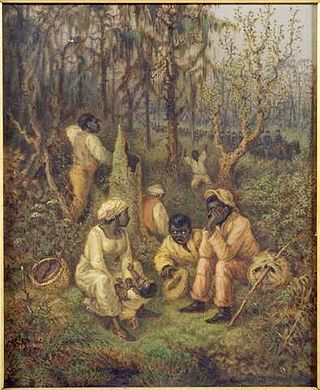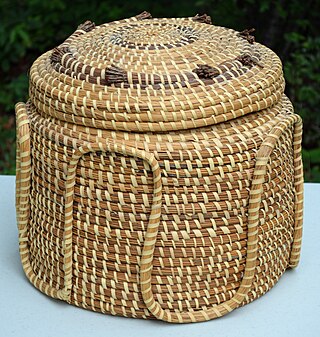Related Research Articles
A mojo, in the African-American spiritual practice called Hoodoo, is an amulet consisting of a flannel bag containing one or more magical items. It is a "prayer in a bag", or a spell that can be carried with or on the host's body. Alternative American names for the mojo bag include gris-gris bag, hand, mojo hand, toby, nation sack,conjure hand, lucky hand, conjure bag, juju bag, trick bag, tricken bag, root bag, and jomo. The word mojo also refers to magic and charms. Mojo containers are bags, gourds, bottles, shells, and other containers. The making of mojo bags in Hoodoo is a system of African-American occult magic. The creation of mojo bags is an esoteric system that involves sometimes housing spirits inside of bags for either protection, healing, or harm and to consult with spirits. Other times mojo bags are created to manifest results in a person's life such as good-luck, money or love.
A Simbi is a water and nature spirit in traditional Kongo spirituality, as well as in Hoodoo and Haitian Vodou.

Gullah is a creole language spoken by the Gullah people, an African-American population living in coastal regions of South Carolina and Georgia as well as extreme northeastern Florida and the extreme southeast of North Carolina.

Hoodoo is a set of spiritual practices, traditions, and beliefs that were created by enslaved Africans in the Southern United States from various traditional African spiritualities, Christianity and elements of indigenous botanical knowledge. Practitioners of Hoodoo are called rootworkers, conjure doctors, conjure man or conjure woman, root doctors, Hoodoo doctors, and swampers. Regional synonyms for Hoodoo include conjure or rootwork. As a syncretic spiritual system, it also incorporates Islam brought over by enslaved West African Muslims and Spiritualism. Scholars define Hoodoo as a folk religion. Folk religions are syncretic traditions between two or more cultural religions, in this case African indigenous spirituality and Abrahamic religion.

The Gullah are an African American ethnic group who predominantly live in the Lowcountry region of the U.S. states of South Carolina, North Carolina, Georgia, and Florida within the coastal plain and the Sea Islands. Their language and culture have preserved a significant influence of Africanisms as a result of their historical geographic isolation and the community's relation to their shared history and identity.

Marquetta L. Goodwine is an author, preservationist, and performance artist who serves as Queen Quet, Chieftess of the Gullah/Geechee Nation.

Fort Mose, originally known as Gracia Real de Santa Teresa de Mose, and later as Fort Mose, or alternatively, Fort Moosa or Fort Mossa, is a former Spanish fort in St. Augustine, Florida. In 1738, the governor of Spanish Florida, Manuel de Montiano, had the fort established as a free black settlement, the first to be legally sanctioned in what would become the territory of the United States. It was designated a US National Historic Landmark on October 12, 1994.

Atlantic Creole is a cultural identifier of those with origins in the transatlantic settlement of the Americas via Europe and Africa.

Joseph A. Opala, OR is an American historian noted for establishing the "Gullah Connection," the historical links between the indigenous people of the West African nation of Sierra Leone and the Gullah people of the Low Country region of South Carolina and Georgia in the United States.
Sierra Leonean Americans are an ethnic group of Americans of full or partial Sierra Leonean ancestry. This includes Sierra Leone Creoles whose ancestors were African American Black Loyalists freed after fighting on the side of the British during the American Revolutionary War. Some African Americans trace their roots to indigenous enslaved Sierra Leoneans exported to the United States between the 18th and early 19th century. In particular, the Gullah people of partial Sierra Leonean ancestry, fled their owners and settled in parts of South Carolina, Georgia, and the Sea Islands, where they still retain their cultural heritage. The first wave of Sierra Leoneans to the United States, after the slavery period, was after the Sierra Leone Civil War in the 1990s and early 2000s. According to the American Community Survey, there are 34,161 Sierra Leonean immigrants living in the United States.

The Great Dismal Swamp maroons were people who inhabited the swamplands of the Great Dismal Swamp in Virginia and North Carolina after escaping enslavement. Although conditions were harsh, research suggests that thousands lived there between about 1700 and the 1860s. Harriet Beecher Stowe told the maroon people's story in her 1856 novel Dred: A Tale of the Great Dismal Swamp. The most significant research on the settlements began in 2002 with a project by Dan Sayers of American University.

The Gullah-Geechee Cultural Heritage Corridor is a federal National Heritage Area in the United States, representing the significant story of the Gullah-Geechee people for maintaining their cultural traditions, and for being a reflection of the values of ingenuity, pride, and perseverance. The intent of the designation is to help us to preserve and interpret the traditional cultural practices, sites, and resources associated with Gullah-Geechee people. Gullah-Geechee Cultural Heritage Corridor, and the federal Gullah-Geechee Cultural Heritage Corridor Commission established to oversee it, were designated by an act of Congress on October 12, 2006 through the National Heritage Areas Act of 2006.
Barbara J. Heath is a professor in the Department of Anthropology at The University of Tennessee, Knoxville who specializes in historical archaeology of eastern North America and the Caribbean. Her research and teaching focus on the archaeology of the African diaspora, colonialism, historic landscapes, material culture, public archaeology and interpretation, and Thomas Jefferson.

Slavery in Cuba was a portion of the larger Atlantic Slave Trade that primarily supported Spanish plantation owners engaged in the sugarcane trade. It was practised on the island of Cuba from the 16th century until it was abolished by Spanish royal decree on October 7, 1886.
Cornelia Walker Bailey was a storyteller, writer, and historian who worked to preserve the Geechee-Gullah culture of Sapelo Island, Georgia.
Edda L. Fields-Black is an African-American historian who is currently associate professor of history at Carnegie Mellon University. She is known for her research on West African rice agriculture and societies and the African diaspora.
Maria Franklin is an associate professor at the University of Texas at Austin. She is a historical archaeologist whose work includes black-feminist theory, African Diaspora studies and race and gender.

The Gullah are African Americans who live in the Lowcountry region of the U.S. states of Georgia, Florida, South Carolina, and North Carolina, in both the coastal plain and the Sea Islands. They developed a creole language, also called Gullah, and a culture with some African influence.
Newton Slave Burial Ground is an industrial heritage site and informal cemetery in Barbados. It was used by people enslaved at the adjacent Newton Plantation. The site has been owned by the Barbados Museum & Historical Society since 1993. It has been subject to excavations since the 1970s, which have produced information regarding slave lifeways including resistance, health, and culture.

Slave quarters in the United States, sometimes called slave cabins, were a form of residential vernacular architecture constructed during the era of slavery in the United States. These outbuildings were the homes of the enslaved people attached to an American plantation, farm, or city property. Some former slave quarters were continuously occupied and used as personal residences until as late as the 1960s.
References
- ↑ Carbondale., Southern Illinois university at (2014). The archaeology of slavery : a comparative approach to captivity and coercion. Southern Illinois University Press. ISBN 978-0-8093-3397-4. OCLC 942745991.
- ↑ "Archaeology Lecture Set March 31". Indiana Gazette. 19 June 1987. Retrieved 11 October 2016– via Newspapers.com.
- 1 2 "Theresa Singleton, Professor, Anthropology". The Maxwell School of Syracuse University. 2009-03-18. Retrieved 2019-11-14.
- ↑ J.C. Harrington Medal in Historical Archaeology: Theresa A. Singleton
- 1 2 Botwick, Bradford (July 2018). "Gullah-Geechee settlement patterns from slavery to freedom: Investigation of a Georgia plantation slave quarter". North American Archaeologist. 39 (3): 198–228. doi:10.1177/0197693118793795. ISSN 0197-6931. S2CID 165182377.
- ↑ Riley, Ricky (9 July 2015). "6 Black Archaeologists and Anthropologists You Should Know About". Blerds. Retrieved 11 October 2016.
- ↑ Seaberry, Jane (September 28, 1991). "Ancient Indian Village Found at Mason Neck". The Washington Post. Retrieved 11 October 2016.
- ↑ "Establishing the Society of Black Archaeologists". Society for Historical Archaeology. 23 April 2012. Retrieved 11 October 2016.
- ↑ "Theresa Singleton, PhD". Black Science Network. Retrieved 11 October 2016.
- ↑ Stephens, Janette E. (December 1986). "The Archaeology of Slavery and Plantation Life. Ed. by Theresa A. Singleton". The Journal of American History. 73 (3): 753–754. doi:10.2307/1903025. JSTOR 1903025.
- ↑ Fagan, Brian (June 2000). "Reviewed Work: "I, Too, Am American": Archaeological Studies of African American Life by Theresa Singleton". International Journal of African Historical Studies. 33 (2): 459–460. doi:10.2307/220718. JSTOR 220718.
- ↑ A., Singleton, Theresa (2016). Slavery Behind the Wall : an Archaeology of a Cuban Coffee Plantation. University Press of Florida. ISBN 978-0-8130-5973-0. OCLC 1002696004.
{{cite book}}: CS1 maint: multiple names: authors list (link)